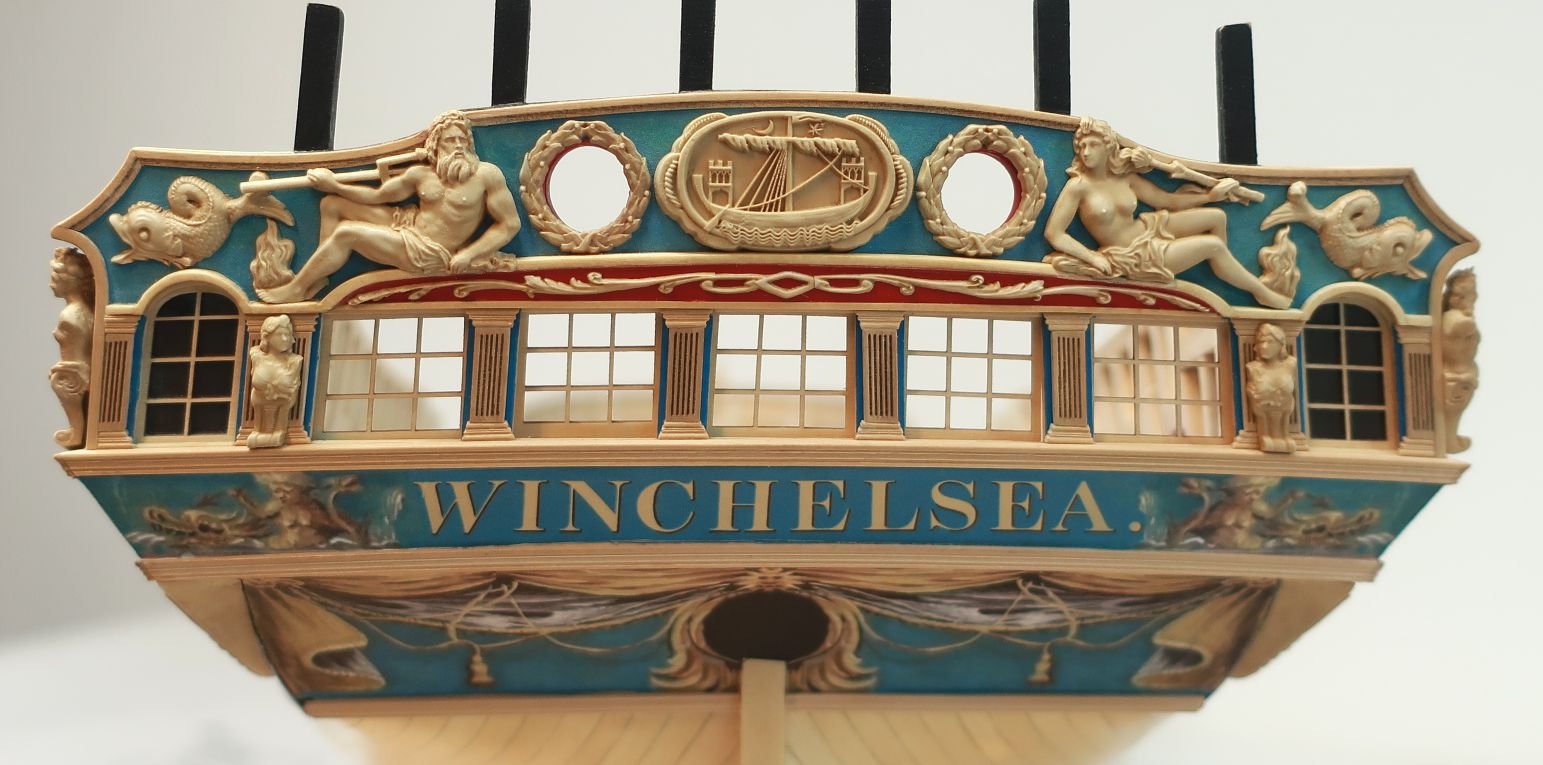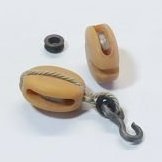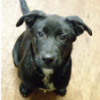Supplies of the Ship Modeler's Handbook are running out. Get your copy NOW before they are gone! Click on photo to order.
×
-
Posts
9,455 -
Joined
-
Last visited
Reputation Activity
-
 Chuck reacted to Erik W in 18th Century Longboat by Erik W - FINISHED - Model Shipways - Scale 1:48 - First wooden ship build
Chuck reacted to Erik W in 18th Century Longboat by Erik W - FINISHED - Model Shipways - Scale 1:48 - First wooden ship build
Got the cap rail done. One of the challenges with this kit has been working with such a poor wood quality. Sanding the cap rail was like sanding shredded wheat. My next build may be something scratch built. At least I'll be able to pick the quality of the wood.
Erik
-
 Chuck got a reaction from fatih79 in HM Cutter Cheerful 1806 by Chuck - FINISHED - 1:48 scale - kit prototype
Chuck got a reaction from fatih79 in HM Cutter Cheerful 1806 by Chuck - FINISHED - 1:48 scale - kit prototype
I agree ken....
The six deck elements that I needed to complete before I started planking the deck are now finished.
The companionway was pretty straight forward. I used 1/32" thick strips glued together edgewise to make the sides and top of the companionway. I darkened the seams before gluing them up with a pencil. I knew they would show through the transparent red paint and add a nice visual detail.
The hinges are laserboard with small lengths of tubes used to simulate them. They are not working hinges though. Each side of the companionway was built in one solid piece and assembled like a box. The hinges were glued on afterwards. I have omitted the coaming as was seen on the photo from that contemporary model.
The last deck element to complete was the coaming where the stove stack will go. That was pretty straight forward as well. I just followed the plans. The height and width for all of the coamings on these six elements varied so Careful attention was needed. I had to build this last one twice after making the coaming too high. I need to look at my plans more often!!!
Chuck
-
 Chuck got a reaction from mtaylor in HM Cutter Cheerful 1806 by Stuntflyer (Mike) - FINISHED - 1:48 scale
Chuck got a reaction from mtaylor in HM Cutter Cheerful 1806 by Stuntflyer (Mike) - FINISHED - 1:48 scale
Very well done!!!b That looks great.... Its so nice I want to trade models Mike
Chuck
-
 Chuck got a reaction from Stuntflyer in HM Cutter Cheerful 1806 by Stuntflyer (Mike) - FINISHED - 1:48 scale
Chuck got a reaction from Stuntflyer in HM Cutter Cheerful 1806 by Stuntflyer (Mike) - FINISHED - 1:48 scale
Very well done!!!b That looks great.... Its so nice I want to trade models Mike
Chuck
-
 Chuck got a reaction from Canute in HM Cutter Cheerful 1806 by Stuntflyer (Mike) - FINISHED - 1:48 scale
Chuck got a reaction from Canute in HM Cutter Cheerful 1806 by Stuntflyer (Mike) - FINISHED - 1:48 scale
Very well done!!!b That looks great.... Its so nice I want to trade models Mike
Chuck
-
 Chuck reacted to Stuntflyer in HM Cutter Cheerful 1806 by Stuntflyer (Mike) - FINISHED - 1:48 scale
Chuck reacted to Stuntflyer in HM Cutter Cheerful 1806 by Stuntflyer (Mike) - FINISHED - 1:48 scale
Over the past three weeks I've been able to complete the planking of first belt below the wales. All of the edge bending was done as described in chapter four. The learning process was a lot of fun and I highly recommend giving the technique a try.
-
 Chuck reacted to GLakie in Armed Virginia Sloop by GuntherMT - FINISHED - Model Shipways - scale 1:48
Chuck reacted to GLakie in Armed Virginia Sloop by GuntherMT - FINISHED - Model Shipways - scale 1:48
Your shrouds look great Brian. I see Chuck's machine is serving you well.
-
 Chuck got a reaction from mrjimmy in 18th century English Longboat by Chuck - FINISHED - c.1760
Chuck got a reaction from mrjimmy in 18th century English Longboat by Chuck - FINISHED - c.1760
You just did
-
 Chuck got a reaction from CharlieZardoz in HM Cutter Cheerful 1806 by Chuck - FINISHED - 1:48 scale - kit prototype
Chuck got a reaction from CharlieZardoz in HM Cutter Cheerful 1806 by Chuck - FINISHED - 1:48 scale - kit prototype
I agree ken....
The six deck elements that I needed to complete before I started planking the deck are now finished.
The companionway was pretty straight forward. I used 1/32" thick strips glued together edgewise to make the sides and top of the companionway. I darkened the seams before gluing them up with a pencil. I knew they would show through the transparent red paint and add a nice visual detail.
The hinges are laserboard with small lengths of tubes used to simulate them. They are not working hinges though. Each side of the companionway was built in one solid piece and assembled like a box. The hinges were glued on afterwards. I have omitted the coaming as was seen on the photo from that contemporary model.
The last deck element to complete was the coaming where the stove stack will go. That was pretty straight forward as well. I just followed the plans. The height and width for all of the coamings on these six elements varied so Careful attention was needed. I had to build this last one twice after making the coaming too high. I need to look at my plans more often!!!
Chuck
-
 Chuck got a reaction from Saburo in WASHINGTON GALLEY by yamsterman - 1/48 scale - POF
Chuck got a reaction from Saburo in WASHINGTON GALLEY by yamsterman - 1/48 scale - POF
I would absolutely change the direction of the scarf joints to what is more commonly acceptable. I looked over the plans very carefully before publishing as did others, and had made several recommendations for changes. This was actually one I had overlooked.
I will certainly make this a new recommendation to Jeff to possibly change it in the guide and plans for future printings. Nice catch. But I will talk to him and see where he is on the subject. But in my opinion, yes the scarfs should go in the other plain as is commonly seen.
Cheers,
Chuck
-
 Chuck reacted to GuntherMT in Armed Virginia Sloop by GuntherMT - FINISHED - Model Shipways - scale 1:48
Chuck reacted to GuntherMT in Armed Virginia Sloop by GuntherMT - FINISHED - Model Shipways - scale 1:48
Thanks everyone for the feedback. I'm actually sort of leaning towards option 1, so as to keep the hull as visible as possible, but what I may do is build all three supports for one side and just not glue them in place so I can compare them visually and make up my mind. It probably takes close to an hour to get one fit right, but that's really nothing in the greater scheme of how much time I've got invested in this little boat!
Back to the swivel guns, after making the yokes, it was time to solder on the handles.
Next I soldered the base rods onto the yokes. This was a pretty good imitation of the keystone cops, as I kept getting the handles too hot and making them fall off, followed by doing the same to the yoke rods when re-attaching the handles. In the future I'm going to invest in some different silver solders that melt at different temps. You do the first joint with high-temp, next one with medium, and the last (if you need three) with low temp solder. They also make some heat-sink compounds that you can place between joints to help keep the one cool.
After filing/cleanup, stuck them on the ship for the pictures.
These will be blackened, and a knob added to the handle end. Obviously they are just dropped into their mounting tubes at this point and are not secured, or that would be pretty interesting!
Going to try JAX chemicals Pewter Black (and brass cleaner) since it should also blacken the solder, whereas the Birchwood Casey Brass Black leaves the solder a gorgeous silver. Thanks to Frank for letting me try his chemicals!
-
 Chuck got a reaction from tlevine in HM Cutter Cheerful 1806 by Chuck - FINISHED - 1:48 scale - kit prototype
Chuck got a reaction from tlevine in HM Cutter Cheerful 1806 by Chuck - FINISHED - 1:48 scale - kit prototype
I agree ken....
The six deck elements that I needed to complete before I started planking the deck are now finished.
The companionway was pretty straight forward. I used 1/32" thick strips glued together edgewise to make the sides and top of the companionway. I darkened the seams before gluing them up with a pencil. I knew they would show through the transparent red paint and add a nice visual detail.
The hinges are laserboard with small lengths of tubes used to simulate them. They are not working hinges though. Each side of the companionway was built in one solid piece and assembled like a box. The hinges were glued on afterwards. I have omitted the coaming as was seen on the photo from that contemporary model.
The last deck element to complete was the coaming where the stove stack will go. That was pretty straight forward as well. I just followed the plans. The height and width for all of the coamings on these six elements varied so Careful attention was needed. I had to build this last one twice after making the coaming too high. I need to look at my plans more often!!!
Chuck
-
 Chuck got a reaction from Elmer Cornish in HM Cutter Cheerful 1806 by Chuck - FINISHED - 1:48 scale - kit prototype
Chuck got a reaction from Elmer Cornish in HM Cutter Cheerful 1806 by Chuck - FINISHED - 1:48 scale - kit prototype
I agree ken....
The six deck elements that I needed to complete before I started planking the deck are now finished.
The companionway was pretty straight forward. I used 1/32" thick strips glued together edgewise to make the sides and top of the companionway. I darkened the seams before gluing them up with a pencil. I knew they would show through the transparent red paint and add a nice visual detail.
The hinges are laserboard with small lengths of tubes used to simulate them. They are not working hinges though. Each side of the companionway was built in one solid piece and assembled like a box. The hinges were glued on afterwards. I have omitted the coaming as was seen on the photo from that contemporary model.
The last deck element to complete was the coaming where the stove stack will go. That was pretty straight forward as well. I just followed the plans. The height and width for all of the coamings on these six elements varied so Careful attention was needed. I had to build this last one twice after making the coaming too high. I need to look at my plans more often!!!
Chuck
-
 Chuck got a reaction from Canute in Cutter Cheerful 1806 by rafine - FINISHED
Chuck got a reaction from Canute in Cutter Cheerful 1806 by rafine - FINISHED
That looks very good. Well done!!
-
 Chuck got a reaction from catopower in HM Cutter Cheerful 1806 by Chuck - FINISHED - 1:48 scale - kit prototype
Chuck got a reaction from catopower in HM Cutter Cheerful 1806 by Chuck - FINISHED - 1:48 scale - kit prototype
I agree ken....
The six deck elements that I needed to complete before I started planking the deck are now finished.
The companionway was pretty straight forward. I used 1/32" thick strips glued together edgewise to make the sides and top of the companionway. I darkened the seams before gluing them up with a pencil. I knew they would show through the transparent red paint and add a nice visual detail.
The hinges are laserboard with small lengths of tubes used to simulate them. They are not working hinges though. Each side of the companionway was built in one solid piece and assembled like a box. The hinges were glued on afterwards. I have omitted the coaming as was seen on the photo from that contemporary model.
The last deck element to complete was the coaming where the stove stack will go. That was pretty straight forward as well. I just followed the plans. The height and width for all of the coamings on these six elements varied so Careful attention was needed. I had to build this last one twice after making the coaming too high. I need to look at my plans more often!!!
Chuck
-
 Chuck got a reaction from mikegerber in HM Cutter Cheerful 1806 by Chuck - FINISHED - 1:48 scale - kit prototype
Chuck got a reaction from mikegerber in HM Cutter Cheerful 1806 by Chuck - FINISHED - 1:48 scale - kit prototype
I agree ken....
The six deck elements that I needed to complete before I started planking the deck are now finished.
The companionway was pretty straight forward. I used 1/32" thick strips glued together edgewise to make the sides and top of the companionway. I darkened the seams before gluing them up with a pencil. I knew they would show through the transparent red paint and add a nice visual detail.
The hinges are laserboard with small lengths of tubes used to simulate them. They are not working hinges though. Each side of the companionway was built in one solid piece and assembled like a box. The hinges were glued on afterwards. I have omitted the coaming as was seen on the photo from that contemporary model.
The last deck element to complete was the coaming where the stove stack will go. That was pretty straight forward as well. I just followed the plans. The height and width for all of the coamings on these six elements varied so Careful attention was needed. I had to build this last one twice after making the coaming too high. I need to look at my plans more often!!!
Chuck
-
 Chuck got a reaction from Archi in HM Cutter Cheerful 1806 by Chuck - FINISHED - 1:48 scale - kit prototype
Chuck got a reaction from Archi in HM Cutter Cheerful 1806 by Chuck - FINISHED - 1:48 scale - kit prototype
Thank You very much,
Today I decided to build the skylight. There are many shapes and sizes shown on cutters. This matches the original draft but I imaging any similar would do. I decided to make this a mini-kit. All of the parts are laser cut from boxwood, laserboard and acetate.
First I doubled up two parts to form the "lip" I will need to build this thing. There are some funky angles on the skylight because after its built the fore and aft sides must be vertical. So it was a challenge to say the least. This was done for the sides and the window frames.
Then the window frames of the roof were beveled on the top and bottom edges. This was very important so they would fit together tightly in the next step. I used an emery board.
Rather than complete the frame and then add these on top, I decided to build the roof first. I tried a first prototype the other way and it was hard to get all of the angles correct and doing it in this order solved the issues. The two halves of the roof were glued to one of the sides as shown. It helped to keep the whole thing squared up and interestingly this made it easier to build..
Then the other side was added and finally the two port and starboard side pieces beneath the window frames. This finished the initial framing. I know I am going to paint this red so I filled even the smallest cracks and sanded it afterwards.
Finally a coaming was added around the skylight frame. This coaming was not as thick or as high as the coaming for the main hatch. Because it was going to be painted I didnt bother with lap joints. Note how the skylight doesnt sit flush on the ground. It is lifted off the coaming by half of the width of the timbers. This helps keep the decorative etched molding nice and neat with equal distance all around it. The fore and aft sides were done first. Then port and starboard. The corners were rounded with the right angle jig like the coamings for the main hatch to finish it up. Then it was painted red.
Finally the laser cut acetate windows were dropped in position along with the skylight window frames. The later was cut from very thin laserboard and painted to look like boxwood. None if these items are glued to the deck yet. I am waiting to finish up the companionway next and then I should be ready to start planking the deck around these elements.
-
 Chuck got a reaction from Archi in HM Cutter Cheerful 1806 by Chuck - FINISHED - 1:48 scale - kit prototype
Chuck got a reaction from Archi in HM Cutter Cheerful 1806 by Chuck - FINISHED - 1:48 scale - kit prototype
Thanks,
Today I started making the coamings for the hatch gratings. There are three, but only two need coamings. The main hatch is shown here. The second smaller grating will be just aft of the windlass.
The gratings were made using the Syren grating kits with camber already built in them.
Then the coamings were built up around the finished gratings. Too often I see folks build the coaming following the plans and then when it comes time to add the grating it wont fit. Sometimes you end up with holes along the coaming or have to shave down the grating too much to fit it into the coaming. By building the coaming around a finished grating I wont have this issue. Now my grating may end up being a hair larger or smaller than the plans but that is less important than having it look correct. We are talking about maybe .025" larger or smaller...thats acceptable.
The coamings were made with the usual lap joints. Note the fore and aft sides have a roundup. These coamings are 1/4" high. Others will be less and not as thick...they are all different but for the two gratings the coamings are 1/4" high x 3/32" thick. But dont forget that the planking will go around them so only 3/16' will be above the planked deck.
Then a right angle jig was used to round off the corners except for what will be the bottom 1/16". The jig is 1/16" thick which will be the same thickness as the planking. I added a strip inside the coaming on the port and starboard sides to create a lip to support the grating as well.
To finish it off I softened the hard corners all around the top edge of the coaming. I may or may not paint the coaming red and leave the grating bright. But I dont know yet. I have seen Cutter models done both ways. There will be a lot of other deck fittings painted red so I dont want to go overboard... . Tomorrow I will make the coaming for the smaller grating behind the windlass.
Chuck
-
 Chuck got a reaction from Archi in HM Cutter Cheerful 1806 by Chuck - FINISHED - 1:48 scale - kit prototype
Chuck got a reaction from Archi in HM Cutter Cheerful 1806 by Chuck - FINISHED - 1:48 scale - kit prototype
Thank You...
In preparation for planking the deck, I added the waterway/margin planks. For my purposes here I talk about them as two separate pieces. First the wider margin plank was created with scarf joints next to the bulwarks. I used card stock to make templates first. There are three lengths as shown below. This required a lot of tweaking until I got it right. Then the templates were traced onto a 1/16" thick sheet of boxwood and cut out. The deck planking will be 1/16" thick.
I spent a lot of time carefully shaping the scarf joints with a #11 blade and some needle files until they were a nice clean and tight fit. Then they were glued onto the deck area. The back edge needed to be beveled so I could get a tight fit against the bulwarks in many areas. Particularly at the bow. A pencil darkened the seam of scarf joint just like the hull planking. Eventually the deck planking will be nibbed into these margin planks.
When finished, I added the waterway on top of the margin plank. It was a 1/32" strip that was slowly sanded to become a 1/4 round. I basically sanded off one corner edge and rounded it off. It was glued on top and the seams between the pieces were carefully lined up with the scarf joints. So again three lengths were used. This way they look like they were done as one piece. These thin strips also needed to be beveled to fit tight against the bulwarks. The bulwarks are unfortunately not at a nice 90 degree angle to the deck so the bevel was an absolute necessity.
Now its time to start building the hatches, coamings and gratings and skylight. Then I can plank the deck around them. I cant wait until thats done,. After this step its just about the small details...and that is a lot of fun.
Chuck
-
 Chuck got a reaction from shipcarpenter in HM Cutter Cheerful 1806 by Chuck - FINISHED - 1:48 scale - kit prototype
Chuck got a reaction from shipcarpenter in HM Cutter Cheerful 1806 by Chuck - FINISHED - 1:48 scale - kit prototype
I agree ken....
The six deck elements that I needed to complete before I started planking the deck are now finished.
The companionway was pretty straight forward. I used 1/32" thick strips glued together edgewise to make the sides and top of the companionway. I darkened the seams before gluing them up with a pencil. I knew they would show through the transparent red paint and add a nice visual detail.
The hinges are laserboard with small lengths of tubes used to simulate them. They are not working hinges though. Each side of the companionway was built in one solid piece and assembled like a box. The hinges were glued on afterwards. I have omitted the coaming as was seen on the photo from that contemporary model.
The last deck element to complete was the coaming where the stove stack will go. That was pretty straight forward as well. I just followed the plans. The height and width for all of the coamings on these six elements varied so Careful attention was needed. I had to build this last one twice after making the coaming too high. I need to look at my plans more often!!!
Chuck
-
 Chuck got a reaction from Archi in HM Cutter Cheerful 1806 by Chuck - FINISHED - 1:48 scale - kit prototype
Chuck got a reaction from Archi in HM Cutter Cheerful 1806 by Chuck - FINISHED - 1:48 scale - kit prototype
I forgot to show the image of the Rogers model which was "zero" help. The companionway is basically shown as a giant solid red cube with smooth sides.
You can see the lower and flattter skylight though. This is at odds with the original draft. But I wonder why so little detail on that cube....
Chuck
-
 Chuck got a reaction from robin b in HM Cutter Cheerful 1806 by Chuck - FINISHED - 1:48 scale - kit prototype
Chuck got a reaction from robin b in HM Cutter Cheerful 1806 by Chuck - FINISHED - 1:48 scale - kit prototype
I agree ken....
The six deck elements that I needed to complete before I started planking the deck are now finished.
The companionway was pretty straight forward. I used 1/32" thick strips glued together edgewise to make the sides and top of the companionway. I darkened the seams before gluing them up with a pencil. I knew they would show through the transparent red paint and add a nice visual detail.
The hinges are laserboard with small lengths of tubes used to simulate them. They are not working hinges though. Each side of the companionway was built in one solid piece and assembled like a box. The hinges were glued on afterwards. I have omitted the coaming as was seen on the photo from that contemporary model.
The last deck element to complete was the coaming where the stove stack will go. That was pretty straight forward as well. I just followed the plans. The height and width for all of the coamings on these six elements varied so Careful attention was needed. I had to build this last one twice after making the coaming too high. I need to look at my plans more often!!!
Chuck
-
 Chuck got a reaction from wyz in HM Cutter Cheerful 1806 by Chuck - FINISHED - 1:48 scale - kit prototype
Chuck got a reaction from wyz in HM Cutter Cheerful 1806 by Chuck - FINISHED - 1:48 scale - kit prototype
I agree ken....
The six deck elements that I needed to complete before I started planking the deck are now finished.
The companionway was pretty straight forward. I used 1/32" thick strips glued together edgewise to make the sides and top of the companionway. I darkened the seams before gluing them up with a pencil. I knew they would show through the transparent red paint and add a nice visual detail.
The hinges are laserboard with small lengths of tubes used to simulate them. They are not working hinges though. Each side of the companionway was built in one solid piece and assembled like a box. The hinges were glued on afterwards. I have omitted the coaming as was seen on the photo from that contemporary model.
The last deck element to complete was the coaming where the stove stack will go. That was pretty straight forward as well. I just followed the plans. The height and width for all of the coamings on these six elements varied so Careful attention was needed. I had to build this last one twice after making the coaming too high. I need to look at my plans more often!!!
Chuck
-
 Chuck reacted to GuntherMT in Armed Virginia Sloop by GuntherMT - FINISHED - Model Shipways - scale 1:48
Chuck reacted to GuntherMT in Armed Virginia Sloop by GuntherMT - FINISHED - Model Shipways - scale 1:48
Since the last opinion poll went so well, time for another one!
I'm now working on the base, inspired by Mobsie (sp?) and another more recent build whose name is completely escaping me at the moment (sorry man).
I'm wondering how many hull supports I should add.
Option 1, just the center one.
Option 2, add two more at the positions marked.
Option 3, all locations.
Thoughts?
-
 Chuck got a reaction from Bobstrake in HM Cutter Cheerful 1806 by Chuck - FINISHED - 1:48 scale - kit prototype
Chuck got a reaction from Bobstrake in HM Cutter Cheerful 1806 by Chuck - FINISHED - 1:48 scale - kit prototype
I agree ken....
The six deck elements that I needed to complete before I started planking the deck are now finished.
The companionway was pretty straight forward. I used 1/32" thick strips glued together edgewise to make the sides and top of the companionway. I darkened the seams before gluing them up with a pencil. I knew they would show through the transparent red paint and add a nice visual detail.
The hinges are laserboard with small lengths of tubes used to simulate them. They are not working hinges though. Each side of the companionway was built in one solid piece and assembled like a box. The hinges were glued on afterwards. I have omitted the coaming as was seen on the photo from that contemporary model.
The last deck element to complete was the coaming where the stove stack will go. That was pretty straight forward as well. I just followed the plans. The height and width for all of the coamings on these six elements varied so Careful attention was needed. I had to build this last one twice after making the coaming too high. I need to look at my plans more often!!!
Chuck












